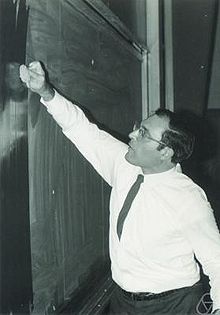- Gian-Carlo Rota
-
Gian-Carlo Rota (* 27. April 1932 in Vigevano, Italien; † 18. April 1999 in Cambridge, Massachusetts, USA) war ein italienisch-amerikanischer Mathematiker, der sich mit Analysis, Wahrscheinlichkeitstheorie und insbesondere mit Kombinatorik beschäftigte. Er gilt als Begründer der modernen Kombinatorik.
Inhaltsverzeichnis
Leben und Werk
Rotas Vater war Bauingenieur und Architekt und musste sich als überzeugter Antifaschist Ende des Zweiten Weltkriegs vor den italienischen Faschisten, auf deren Todesliste er stand, in Norditalien verstecken.[1] Einer seiner Onkel war Drehbuchautor für Federico Fellini. Rota wanderte mit seiner Familie erst nach Ecuador aus. 1950 ging Rota zum Studium in die USA. Von 1950 bis 1953 studierte er an der Princeton University (Bachelor-Abschluss summa cum laude), 1954 an der Yale University (Master-Abschluss 1954), wo er an dem Seminar teilnahm, aus dem das bekannte Lehrbuch Linear Operators von Nelson Dunford und Jacob T. Schwartz hervorging. 1956 promovierte er bei Jacob T. Schwartz an der Yale University über Differentialgleichungen (Extension theory of differential operators[2]). 1956/7 war er als Post-Doc am Courant Institute of Mathematical Sciences of New York University und danach bis 1959 Benjamin Pierce Instructor in Harvard. Ab 1959 war er am Massachusetts Institute of Technology, wo er den Rest seiner Karriere blieb, bis auf zwei Jahre 1965 bis 1967 an der Rockefeller University. Er war Professor für Angewandte Mathematik am MIT und ab 1972 zusätzlich für Philosophie. Zusätzlich arbeitete er für das Los Alamos National Laboratory (als Berater 1966 bis 1971 und schließlich als Senior Fellow des Labors, an dem er Vorlesungen hielt), wo auch sein Freund Stanislaw Ulam arbeitete. 1966 bis 1971 war er Berater bei der Rand Corporation und 1969 bis 1973 am Brookhaven National Laboratory. Außerdem arbeitete er für die National Security Agency (NSA), deren Medal of Distinguished Service er 1992 erhielt. Er starb unerwartet zu Hause im Schlaf an einem Herzinfarkt.
Rota arbeitete zuerst über Funktionalanalysis und Differentialgleichungen und kam über die Ergodentheorie zur Kombinatorik. 1964 veröffentlichte er eine Arbeit On the Foundations of Combinatorial Theory[3] die das Gebiet der Kombinatorik, vorher überwiegend als eine kaum miteinander verbundene Ansammlung mathematischer Tricks betrachtet, vollkommen erneuerte und in die Hauptströmungen der Mathematik einbettete. Unter demselben Serientitel erschienen 1970 bis 1972 und 1992 noch neun weitere Arbeiten. 1988 erhielt er dafür den Leroy P. Steele Prize der American Mathematical Society,
Er war seit 1956 mit Teresa Rondón verheiratet (Scheidung 1980). Rota sprach neben Italienisch und Englisch auch fließend Französisch und Spanisch. Er hatte auch philosophische Interessen, schrieb philosophische Essays und war Mitglied mehrerer philosophischer Gesellschaften wie dem Heidegger Circle und dem Husserl Circle.
1982 wurde er Mitglied der National Academy of Sciences und war außerdem Mitglied der American Academy of Arts and Sciences, der argentinischen Akademie der Wissenschaften, des Institute of Mathematical Statistics. 1995 bis 1997 war er Vizepräsident der American Mathematical Society. Rota war mehrfacher Ehrendoktor (Universität Straßburg, L´Aquila, Bologna, Brooklyn Polytechnical University)
Zu seinen Doktoranden zählt Richard P. Stanley.
Schriften
- Joseph P. Kung (Herausgeber): Gian-Carlo Rota on combinatorics – introductory papers and commentaries, Boston, Birkhäuser Verlag 1995
- mit Daniel Klain: Introduction to geometric probability, Cambridge University Press 1997
- mit Garrett Birkhoff: Ordinary Differential Equations, Boston, Ginn 1962, Blaisdell 1969, 3. Auflage, Wiley 1978
- mit Mark Kac, Jacob T. Schwartz: Discrete Thoughts – essays on mathematics, science and philosophy, Birkhäuser 1992, 2008
- mit Henry Crapo: On the foundations of combinatorial theory II: combinatorial geometries, MIT Press, Studies in Applied Mathematics, 1970, Reprint 1977
- mit P. Doubilet, J. Stein: On the foundations of combinatorial theory IX: Combinatorial methods in invariant theory, Studies in Applied Mathematics, Bd.53, 1974, S.185-216
- mit Joel Stein, Frank Grosshans: Invariant theory and superalgebras, AMS 1987
- mit P. Doubilet: Finite operator calculus, Academic Press 1975
- mit Joseph Kung, Catherine Yan: Combinatorics – The Rota Way, Cambridge University Press 2009
- Jean Dhombres, Kung, Starr (Herausgeber): Gian-Carlo Rota on analysis and probability, selected papers with commentaries, Birkhäuser 2003
- Indiscrete Thoughts, Birkhäuser, 1997 (Essays)
- Rota The many lives of lattice theory, Notices AMS, Dezember 1997, pdf Datei (112 kB)
- Rota, David Sharp Mathematics, Philosophy and Artificial Intelligence 1985, Rota: The Lost Cafe, 1987, Online in Los Alamos Science
- Rota, Kung „The invariant theory of binary forms“, Bulletin AMS, Bd.10, 1984, S.27
- mit Ira Gessel (Herausgeber): Classic Papers in Combinatorics, Birkhäuser 1987 (auch einige von Rotas eigenen Arbeiten sind hier wieder abgedruckt)
- Rota Light Shadows- Remembrances of Yale in the early 50s, Mathematical Intelligencer Bd.18, 1996, Nr.3
Literatur
- J-M Kantor: Gian-Carlo Rota (1932-1999), Gazette des Math., 1999, S. 96-97.
- E. F. Beschler, D. A. Buchsbaum, J. T. Schwartz, Richard P Stanley, B. D. Taylor, M. Waterman: Gian-Carlo Rota (1932-1999), Notices American Mathematical Society, Bd. 47, 2000, Heft 2, S.203-216, pdf Datei (189 kB)
- Bruce Sagan, Richard Stanley (Herausgeber): Mathematical Essays in Honor of Gian-Carlo Rota, Birkhäuser 1998
Weblinks
- Literatur von und über Gian-Carlo Rota im Katalog der Deutschen Nationalbibliothek
- Gian-Carlo Rota. In: MacTutor History of Mathematics archive (englisch)
- Rota „Ten lessons i wish i had been taught“, pdf Datei (72 kB)
- Kranz, Review von Rota „Indiscrete Thoughts“, pdf Datei (106 kB)
- Biografie am MIT, Postscript Datei
Anmerkungen und Einzelnachweise
- ↑ Seine Schwester Ester Rota Gasperoni berichtet über die Flucht der Familie in zwei Büchern Orage sur le lac, L´arbre des Capulies, erschienen bei L´Ecole des Loisirs, 1995, 1996
- ↑ Communications in Pure and Applied Mathematics 1958
- ↑ Teil 1 Theory of Möbius Functions, Zeitschrift für Wahrscheinlichkeitstheorie, Bd.2, 1964, S.340-368
Kategorien:- Mathematiker (20. Jahrhundert)
- Hochschullehrer (MIT)
- US-Amerikaner
- Geboren 1932
- Gestorben 1999
- Mann
Wikimedia Foundation.

